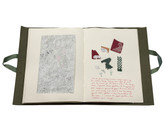Description
The Works of Geoffrey Chaucer
Published by The Kelmscott Press, Hammersmith in 1896
Limited to 438 Copies
Unique Inlaid Leather Binding by Jamie Kamph, Stonehouse Bindery
Exceptional Condition
Binding Details: The Works of Geoffrey Chaucer is beautiful unique onlaid leather binding designed and executed by Jamie Kamph in 2017/2018. The book is bound in full black calf leather and features elaborate multi-colored calf leather floral inlays inspired by a design by William Morris. The borders around the floral inlays consist of elaborate gold gilt titling on both the front and rear covers. The spine is additionally decorated with the floral inlay motif. There are handsewn silk endbands and hand-crafted endsheets and pastedowns. The book is housed in a custom made clamshell box that is covered in William Morris designed wallpaper that was the inspiration for the binding design. The box is designed to allow for the book to be viewed with the box open and also permit to the book to be easily transported.
Included with the book is a portfolio by Jamie Kamph that contains information about the binding as well are her drawing that formed the basis for her binding. The binding was designed and executed in 2017/2018.
Book Details: Universally acclaimed as one of the great achievements in printing history, this is the “Works of Geoffrey Chaucer” published by The Kelmscott Press, Hammersmith in 1896 with a limitation of 438 copies (425 on paper and 13 on vellum).
The most important figure in the revival of printing in England at the end of the 19th century, William Morris (1834-96) had fallen in love with Chaucer's works when he and Burne-Jones were students at Oxford. With the founding of the Kelmscott Press (and, in effect, the launching of the modern private press movement) in 1891, Morris began plans almost immediately for the Chaucer. The press at 14 Upper Mall began producing the book in August of 1894, but it was not until June of 1896 that any completed copies became available. Morris was already a sick man, and Burne-Jones had privately worried that his friend might not live to see his dream realized. Morris died not long afterward. Like the Gutenberg Bible and Caxton's first printing of Chaucer in 1478, the present monumental folio is one of the world's printing masterpieces. In the words of "Artist & the Book, 1860-1960," the Kelmscott Chaucer, for which both Morris and Burne-Jones "worked in the neo-Medieval idiom bequeathed by the Pre-Raphaelites, . . . is perhaps the most famous book of the modern private press movement, and the culmination of William Morris' endeavor." Ray says that the book "is not only the most important of the Kelmscott Press' productions; it is also one of the great books of the world." The borders designed by Morris are incredibly rich and lush. The work would be extraordinary even without the designs by Burne-Jones, but these are certainly the book's most compelling feature. The original plan had been for 60 illustrations, but this grew to 87 before the work was done. While other illustrated Chaucers, beginning with Caxton's, had usually limited images largely to individual portraits of each Canterbury pilgrim, Burne-Jones chose instead to draw complex vignettes illustrating the pilgrims' tales (as well as Chaucer's other works). Part of the dramatic impression left by the book results from the cumulative power of the very large number of impressive bordered pages one encounters going through the text. The intricate woodcut frames are used a total of 118 times, and each one of them enlivens a page nearly 18 inches tall. The impression is especially memorable when the framed pages face each other: 36 of the Burne-Jones cuts with their borders are opposite one another in 18 particularly beautiful openings, and there are several other remarkable openings (including the first one) where a woodcut with its frame faces a bordered text. The present copy is remarkably clean.
About the Artist: Jamie Kamph is an author, educator, book conservator, and artist widely recognized as one of most knowledgeable and accomplished bookbinders in the world. She began her career working with Hope G. Weil before opening her own studio, The Stonehouse Bindery, in 1973. Her writings on bookbinding have been widely published in magazines and she is the author of “A Collectors Guide to Bookbinding, published by in 1982 by the Bird and Bull Press and “Tricks of the Trade: Confessions of a Bookbinder”, published by the Oak Knoll Press in 2015. Her design bindings are housed in private collections and institutions worldwide including Princeton University, The Metropolitan Museum of Art, The Pierpont Morgan Library, the New York Public Library, and the Bridwell Library at the University of Texas. Many of her other bindings have been widely exhibited in such places as the Metropolitan Museum of Art, the Grolier Club, Yale University, and the Aspen Art Institute. In 2003, she was awarded the Helen Ward DeGolyer Award for American Bookbinding.
Condition Report: The binding and clamshell box are in exceptional condition. Internally, the book is very clean. This is partially explained by the fact that the volume was contained within an acetate dust wrapper and kept basically undisturbed for the past 70 years; in any case, given the book's size and the avidity with which copies would normally be looked at, it is highly unlikely that another Kelmscott Chaucer would be in a condition better than is seen here..
Photographs of the binding, clamshell box, and Jamie Kamph’s design portfolio for the binding appear in the photo section of the listing.















